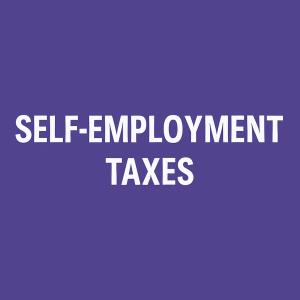Self-Employment Taxes in 2025: What You Need to Know
By Crystal Wilson, Enrolled Agent & Senior Executive Tax Strategist
Crystal Clear Tax – Clearing the Path to Success

Overview
Running your own business is rewarding, but it also means carrying the full weight of your tax responsibilities. When you are self-employed, you pay both the worker and employer portions of Social Security and Medicare. This combined tax is called the self-employment tax, and for many business owners, it is one of the biggest surprises at tax time.
The good news is there are ways to manage and reduce these taxes, but it is important to understand the rules and trade-offs.
What is the self-employment tax?
The self-employment tax funds Social Security and Medicare. Employees split this cost with their employer, but when you are self-employed you cover both sides.
- Social Security tax: 12.4% on net earnings up to $168,600 (for 2025).
- Medicare tax: 2.9% on all net earnings, plus an extra 0.9% if you earn more than $200,000 (single) or $250,000 (married filing jointly).
Together, this is a 15.3% tax on your business profit, before even counting income taxes.
Key changes under H.R.1 (One Big Beautiful Bill)
Recent tax law made a few adjustments that matter for self-employed individuals:
- The cap on state and local tax (SALT) deductions was raised, which may indirectly lower taxable income for some.
- Energy credits were reduced, so fewer “green” tax breaks are available.
- Rules for tips, overtime, Pell Grants, and student loans were updated, which may affect taxable income for certain groups.
How to reduce self-employment taxes
1. Deduct your business expenses
Your net profit is business income minus deductible expenses. Every legitimate expense you claim lowers both income tax and self-employment tax. Examples: office supplies, mileage, home office costs, advertising, professional fees, insurance, and equipment.
2. Take the self-employment tax deduction
You can deduct about half of your self-employment tax on your Form 1040. This doesn’t erase the tax but it lowers your taxable income.
3. Contribute to retirement accounts
Plans like a Solo 401(k) or SEP IRA reduce your taxable income and help you save for the future at the same time.
4. Be strategic with health insurance
Self-employed health insurance premiums can be deducted, lowering taxable income.
5. Consider an S Corporation — with caution
An S Corp can sometimes reduce self-employment tax by allowing you to split your income between a salary (which is taxed for Social Security and Medicare) and profit distributions (which generally are not).
But there are trade-offs:
- An S Corp requires you to pay yourself a reasonable salary through payroll.
- You will file two tax returns each year: a corporate return (Form 1120-S) and your personal return.
- Bookkeeping, payroll, and compliance costs are higher.
- If not structured properly, the IRS can challenge your salary or distributions.
Because of these added responsibilities and costs, an S Corp only makes sense once your business is earning enough profit to offset the extra expenses. At Crystal Clear Tax, we run the numbers with clients before ever recommending this option.
Common mistakes to avoid
- Forgetting to make quarterly estimated tax payments.
- Mixing business and personal expenses.
- Not keeping receipts, mileage logs, or supporting documentation.
- Jumping into an S Corp without understanding the added costs and filing requirements.
How Crystal Clear Tax can help
At Crystal Clear Tax, we believe in educating clients so you make the best decision for your situation. We help you:
- Review your self-employment tax exposure and plan ahead.
- Identify every deduction available to your business.
- Compare entity structures and only recommend an S Corp if it clearly benefits you after costs.
- Build long-term strategies that align with both your business and personal financial goals.
Bottom line
Self-employment taxes are real, but they can be managed with careful planning. The key is knowing when to stick with a simple structure and when it may be time to consider options like an S Corp. At Crystal Clear Tax, we make sure you have the full picture — benefits, risks, and costs — so you never make a decision that hurts more than it helps.
Ready to see what works best for your business? Schedule your consultation today and let us clear the path to smart tax savings.
Reference: IRS Self-Employment Tax rules and H.R.1 (119th Congress) summary 【congress.gov†source】

